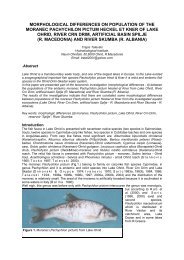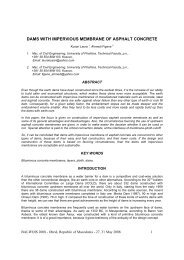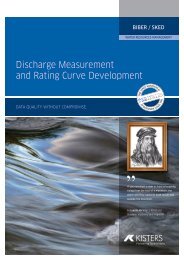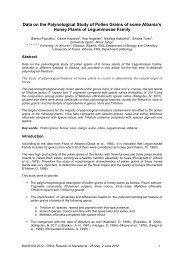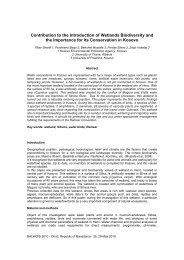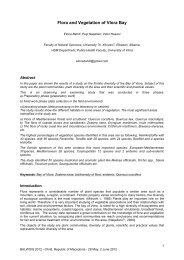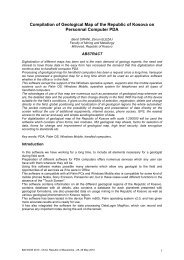The State for Spherule Research in Albania and their Role ... - Balwois
The State for Spherule Research in Albania and their Role ... - Balwois
The State for Spherule Research in Albania and their Role ... - Balwois
You also want an ePaper? Increase the reach of your titles
YUMPU automatically turns print PDFs into web optimized ePapers that Google loves.
For two years we have collected 380 samples from these sediments <strong>in</strong> <strong>Albania</strong> <strong>for</strong> the future spherule<br />
research. Samples are here <strong>in</strong> the Geological Institute of Hungary. We have also 50 th<strong>in</strong> sections from<br />
these <strong>Albania</strong>n sediments <strong>for</strong> the paleontological <strong>and</strong> sedimentological correlations.<br />
After discuss with the Hungarian participations of the IGCP 384 it seems that the deep neritic, pelagic<br />
<strong>and</strong> bathyal sediments are the bests <strong>for</strong> spherule correlation horizon.<br />
<strong>The</strong> question of the future is to organize the laboratory work of the sediments <strong>and</strong> <strong>in</strong>strumental<br />
analysis of the spherules.<br />
<strong>Spherule</strong> <strong>Research</strong> <strong>in</strong> <strong>Albania</strong>.<br />
For five years (1996-2000) we have collected 438 samples from the sediments <strong>in</strong> <strong>Albania</strong> <strong>for</strong> the spherule<br />
research. 367 of them are <strong>in</strong> the Geological Institute of Hungary <strong>and</strong> 70 to Milano University (number 368-<br />
438). We have also 50 th<strong>in</strong> sections from these <strong>Albania</strong>n sediments <strong>for</strong> the paleontological <strong>and</strong><br />
sedimentological correlations. After discussion with other participation’s of the IGCP 384 it seems that the<br />
deep neritic, pelagic <strong>and</strong> bathial sediments are the bests <strong>for</strong> spherule correlation horizons.<br />
<strong>The</strong> first results (from~150 samples that are analised <strong>in</strong> Budapest) have been obta<strong>in</strong>ed <strong>in</strong> the Kopliku<br />
square. 21 magnetic <strong>and</strong> only two glassy spherulites were resulted among 23 analised samples. <strong>The</strong><br />
samples are taken from, Pleistocene <strong>and</strong> Holocene age. <strong>The</strong>ir material consist of different k<strong>in</strong>d of clays,<br />
silts, s<strong>and</strong>s <strong>and</strong> s<strong>and</strong>stoun. Holocen samples have no spherule content. We have found 9 black, rounded,<br />
magnetic spherules <strong>in</strong> the Pleictocene age samples.<br />
Interest<strong>in</strong>g fossil assemblages also can be found <strong>in</strong> the Pliocen age samples. they are: g a s t r o p o d<br />
e , b i v a l v o r , d e n t a l i u m e , p t e r o p o d (macrofauna) <strong>and</strong> f o r a m i n i f e r (mikrofauna).<br />
accord<strong>in</strong>g to this <strong>for</strong>ms was determ<strong>in</strong>ed the piaçensiane <strong>and</strong> astiane age, belong<strong>in</strong>g to the 2 facies: clay-<br />
silt (piaçensiane) <strong>and</strong> s<strong>and</strong>-s<strong>and</strong>stone (astiana). For <strong>in</strong>stance some species: p e c t i n a t a p l i a s t i e<br />
n s i s , f l a b i l l i p e c t e n b o s n i a s c k i i e t c.<br />
We consider, with favorable presence of spherules, these geological events: Pliocen <strong>and</strong> Pleistocene<br />
age, Upper Eocen, K/T boundary, Triasic-Jurasic transition, Permian-Triasic transition.<br />
<strong>Spherule</strong> research possibility <strong>in</strong> Permian-Triassic, Triassic–Jurassic <strong>and</strong> Cretaceous-Tertiary<br />
boundary <strong>in</strong> Albanides<br />
An overview of the geology, Sazani Zone, Jonian Zone, Kruja Zone, Krasta - Cukali Zone, Alpe Zone,<br />
Mirdita Zone, Korabi Zone, Gashi Zone, <strong>Albania</strong>n - <strong>The</strong>salian <strong>in</strong>ner bas<strong>in</strong>, <strong>The</strong> pre-Adriatic depression,<br />
<strong>The</strong> question of the future<br />
For four years (1996-1999) we have collected 438 samples from the sediments <strong>in</strong> <strong>Albania</strong> <strong>for</strong> the<br />
spherule research. 367 samples are <strong>in</strong> the Geological Institute of Hungary <strong>and</strong> 70 to your <strong>in</strong>stitution<br />
(number 368-438). We have also 50 th<strong>in</strong> sections from these <strong>Albania</strong>n sediments <strong>for</strong> the paleontological<br />
<strong>and</strong> sedimentological correlations. After discussion with the hungarian participation’s of the IGCP 384 it<br />
seems that the deep neritic, pelagic <strong>and</strong> bathial sediments are the bests <strong>for</strong> spherule correlation horizons.<br />
<strong>The</strong> first results (from~150 samples that are analised <strong>in</strong> Budapest) have been obta<strong>in</strong>ed <strong>in</strong> the Kopliku<br />
square. 21 magnetic <strong>and</strong> only two glassy spherulites were resulted among 23 analised samples. <strong>The</strong><br />
samples are taken from, Pleistocene <strong>and</strong> Holocene age (HoxhajJ.,CaraF.,SoltP.,DonG.1998). <strong>The</strong>ir<br />
material consist of different k<strong>in</strong>d of clays, silts, s<strong>and</strong>s <strong>and</strong> s<strong>and</strong>stoun. Holocen samples have no spherule<br />
content. We have found 9 black, rounded, magnetic spherules <strong>in</strong> the Pleictocene age samples.<br />
Pliocen samples have remarkable spherule content, 21 magnetic <strong>and</strong> 2 glassy spherules have been<br />
found <strong>in</strong> the samples. Interest<strong>in</strong>g fossil assemblages also can be found <strong>in</strong> the Pliocen age samples. they<br />
are: g a s t r o p o d e , b i v a l v o r , d e n t a l i u m e , p t e r o p o d (macrofauna) <strong>and</strong> f o r a m i n i f e r<br />
(mikrofauna). Accord<strong>in</strong>g to this <strong>for</strong>ms was determ<strong>in</strong>ed the piaçensiane <strong>and</strong> astiane age, belong<strong>in</strong>g to the<br />
2 facies: clay - silt (piaçensiane) <strong>and</strong> s<strong>and</strong> - s<strong>and</strong>stone (astiana). For <strong>in</strong>stance some species: p e c t i n a t<br />
a p l i a s t i e n s i s , f l a b i l l i p e c t e n b o s n i a s c k i i e t c.<br />
We, as you, consider, with favorable presence of spherules, these geological events: Pliocen <strong>and</strong><br />
Pleistocene age. Upper Eocen. K/T boundary. Triasic-Jurasic transition. Permian-Triasic transition.<br />
<strong>The</strong> Cenomanian-Turonian boundary <strong>in</strong> <strong>Albania</strong> <strong>and</strong> the possibility <strong>for</strong> the spherule research.<br />
<strong>The</strong> Albanides are derived <strong>in</strong>to External Zones, show<strong>in</strong>g a cont<strong>in</strong>uous sedimentation rang<strong>in</strong>g from Trias to<br />
Eocene, <strong>and</strong> Internal Zones that <strong>in</strong>clude the Mirdita ophiolites, which were folded dur<strong>in</strong>g the Jurassic <strong>and</strong><br />
Cretaceous tectonic phases.<br />
BALWOIS 2010 - Ohrid, Republic of Macedonia - 25, 29 May 2010<br />
4



